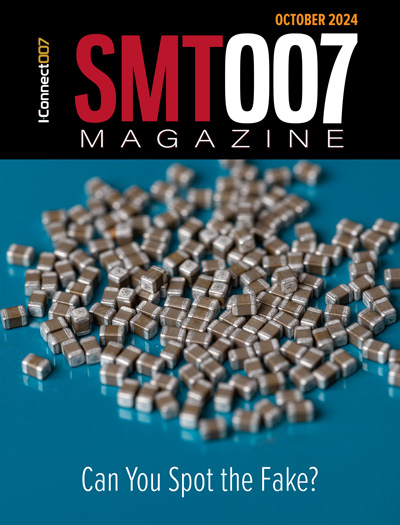-

- News
- Books
Featured Books
- smt007 Magazine
Latest Issues
Current Issue
The Rise of Data
Analytics is a given in this industry, but the threshold is changing. If you think you're too small to invest in analytics, you may need to reconsider. So how do you do analytics better? What are the new tools, and how do you get started?

Counterfeit Concerns
The distribution of counterfeit parts has become much more sophisticated in the past decade, and there's no reason to believe that trend is going to be stopping any time soon. What might crop up in the near future?

Solder Printing
In this issue, we turn a discerning eye to solder paste printing. As apertures shrink, and the requirement for multiple thicknesses of paste on the same board becomes more commonplace, consistently and accurately applying paste becomes ever more challenging.
- Articles
- Columns
Search Console
- Links
- Media kit
||| MENU - smt007 Magazine
Silicon to Systems: Collaboration Between IC and PCB Design Continues
October 2, 2024 | Andy Shaughnessy, Design007Estimated reading time: 1 minute
The walls are coming down between the designers of chips and PCBs. Because of the complexity of electronic systems, IC designers and PCB designers are increasingly finding themselves in need of information from technologists upstream and downstream, from silicon through the system level.
Stephen Chavez, senior product marketing manager at Siemens, shares his thoughts on this silicon-to-systems approach and what it means for PCB designers, EDA tool providers, and system-level developers as well.
More technologists are pointing out the need for PCB designers to focus on silicon-to-systems. What does that term mean to you and to EDA companies like Siemens?
Stephen Chavez: Silicon-to-systems refers to a holistic approach in electronics design where the interaction and integration of silicon (ICs, chips) are considered all the way through to the system level (PCBs, full electronic products). For EDA companies like Siemens, this means developing tools and methodologies that support seamless design flows from the chip level up to the complete system. This approach ensures that all components work together efficiently, reduces design iterations, and improves time-to-market by addressing potential integration issues early in the design process.
What do PCB designers need to understand about silicon and packages?
PCB designers must understand the following aspects of silicon and packages:
- Signal integrity and power integrity: As signals travel from silicon through the package to the PCB, maintaining signal quality and managing power distribution is critical. PCB designers must account for high-speed signal requirements, impedance control, and proper power delivery network design to avoid noise in regard to crosstalk, EMI, and EMC.
- Thermal management: Higher integration and power densities in silicon and packages lead to heat generation. Designers must incorporate effective thermal management solutions, such as heat sinks, thermal vias, and appropriate material choices.
- Land patterns and layout considerations: Understanding the physical and electrical requirements of IC packages is crucial. This includes correct pin mapping, accommodating different package types (e.g., BGA, LGA, microBGAs, QFP, etc.), and ensuring sufficient spacing and layer stackup to include the necessary via technologies to support the chip's needs.
- Design for manufacturing: Awareness of the manufacturing processes for both silicon and PCB can help designers create designs that are easier to manufacture, test, and assemble, reducing costs and time. Close collaboration with your external suppliers is key to success.
To read the rest of this article in the September 2024 issue of Design007 Magazine, click here.
Suggested Items
Rules of Thumb: A Primer
11/14/2024 | Andy Shaughnessy, Design007 MagazineMany industry-wide rules of thumb are based on DFM constraints or formulas, but others are based on tribal knowledge. In this interview, Andy Shaughnessy sits down with our contributors Kris Moyer and Kelly Dack to discuss the role of rules of thumb, when to employ them, and when it’s time to do the math.
Elementary, Mr. Watson A Designer's Dilemma—Metric or Imperial Units?
11/07/2024 | John Watson -- Column: Elementary, Mr. WatsonIn the early 1800s, as trains began to spread across the United States, different companies built their tracks in ways that made sense to them. They chose their track widths (gauges) with no set standard. Some tracks were about four feet wide, with others at five or even six feet. Each company thought their choice was best, but this led to a big problem: Trains from one track couldn't run on another if the gauges didn't match. Often, trains had to stop at the state line for all their goods and passengers to switch trains, which cost extra time and money.
One Partial HDI Technique: mSAP
11/05/2024 | Andy Shaughnessy, Design007 MagazineChris Hunrath, vice president of technology at Insulectro, believes that mSAP just might be the trick for designers considering partial HDI. As Chris explains, the materials and equipment required for the mSAP process are easily available, and the process is well established. This could be a great option for designers working with BGAs that have a pitch of 0.5 mm or less.
Global PCB Connections: Mission Critical—Communication Between PCB Designers and Fabricators
10/24/2024 | Jerome Larez -- Column: Global PCB ConnectionsIn my first column, I want to discuss the critical importance of communications between the PCB design and the PCB fabrication engineer. I’ll explore why clear communication is so important, highlight the differences between standard and CTQ items, and outline the key issues that must be agreed upon to achieve success in PCB manufacturing.
The Shaughnessy Report: Are You Partial to Partial HDI?
10/08/2024 | Andy Shaughnessy -- Column: The Shaughnessy ReportSometimes, a little technology is all you need. Star Trek’s Borg character only needs a funky eyepiece contraption to access all The Collective’s data, like an outer space Wi-Fi. Like the Borg’s eyepiece, we may only need a little bit of HDI in one corner of the board. We might only need partial HDI.


